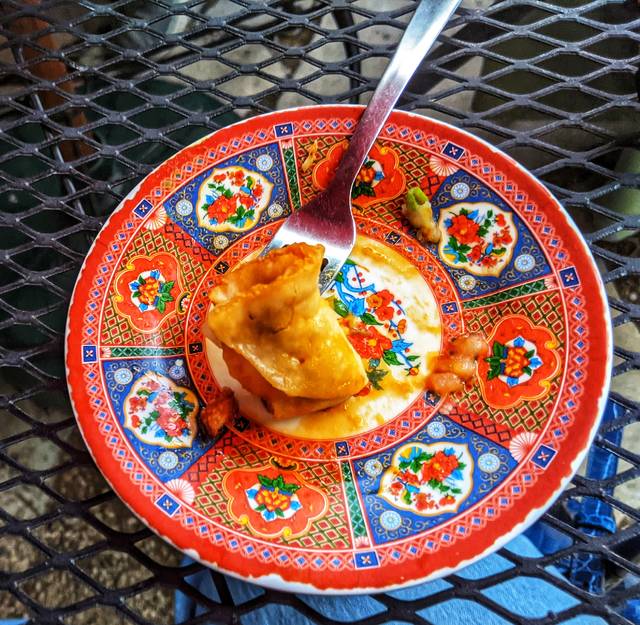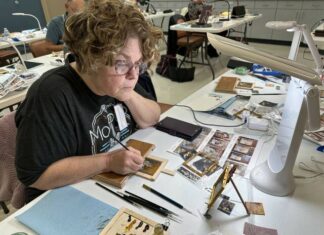
A few weeks ago I met friends at one of my favorite restaurants in Bloomington, Ind., Anyetsang’s Little Tibet Restaurant. We gorged ourselves on a Tibetan feast, even purchasing enough to bring home for another meal. But the favorite part of the meal, loved by all, was the hot sauce. It’s undoubtedly my favorite hot sauce.
It’s a big week. This Sunday I’m turning 40. I’ve been told all sorts of different things I should be feeling but so far content and happy are tying for first. No major lifestyle change, except maybe more tenacious than ever. But I feel like we all are after the last year we had.
This morning while driving through the tender hillside of May’s Lick, I was reminded of a not so long ago time when I was driving around the hills of another beautiful region of Kentucky. It had reminded me so much of Mason County, but it wasn’t home. I’d put myself in a similar predicament a few years before that and had thought it was lovely and inspiring, but it wasn’t Kentucky.
The hills and dips throughout our riverside counties and creeks can build you up, but it’s the big hearts and adventurous eaters that are my favorite testimony to the folks who populate our area.
I had the opportunity to grow up in Maysville, but to be honest it wasn’t until I came back as an adult that I realized what a gift Maysville was to the life I wanted to experience. The eaters of this region not only appreciate the cultivations and flavors of the river valley, but are hungry to taste the world. I have never enjoyed feeding folks and discussing food with farmers more than this region of the world. Wherever I have visited, I always end up comparing it with parts of my life in Maysville.
Shortly after college, I had the great pleasure of visiting and exploring India. Although I started in central India, New Delhi, I quickly found myself in Amritsar on the India-Pakistani border spending time with a gracious host family and my American best friend from university, Leah Bruton. Leah instigated the trip even happening to begin with. We met my freshman year at Indiana University, where she quickly informed me to start saving up because we were going to India in five years.
We had cooked together for work and pleasure throughout college, so it was no surprise when my friend had based the next few weeks of traveling around food and cooking. The miles we clocked in such a quick time were nothing compared to the many exquisite sights and smells experienced. Women wrapped in beautiful jewel-toned saris showed us the real India through their delicious and heart-felt dishes and meals. Street vendors surprised us with unexpected delights. Spices in colors and textures I had only experienced on paper stepped out of the print and onto my plate. Not to mention the snake charmers and exciting new languages and accents I never could have dreamed of.
During our travels, we spent a great bit of time in McLeod Ganj, a small suburb of Dharamshala. This beautiful terrain is located in the foothills of the Himalayas and is home to the Tibetan Government-in-exile and His Holiness The Dalai Lama. Of all my travels, I have never met a more gracious and thoughtful person than the Tibetans living among the great mountains of the north.
Leah and I quickly enrolled in as many cooking classes upon arriving in the region. When word got around to our instructor that Leah was a teacher, we were approached to see if we would be interested in an exchange with local monks, cooking classes for English reading and writing lessons.
The monks were living in refuge at the cooking school. They had escaped what was Tibet and now is China through the dangerous Himalayan Mountains. Prior to their escape, they had been kidnapped and tortured by the Chinese Government. They were now no longer capable of functioning in the monasteries as they had before. This gracious cooking school provided the monks an opportunity to teach and be provided for. They wanted to read and write in English so that they could tell their story.
Of course, we leaped at the opportunity. We would have been fools to say no, so we quickly rearranged our traveling and made our home in the mountains for the weeks that followed. We then discovered His Holiness the Dali Lama would be holding a special seminar in the area and we extended our trip again. This loving community was our home for what seems now like a lifetime away.
Tibetan cooking and Indian cooking are incredibly different, however, both vary region by region and share a few similarities. What struck me so much about Tibetan cooking was the use of celery, garlic, and onion. These were all ingredients my mother put in everything. These were ingredients in all my old church cookbooks and staples in the refrigerator. There I was a world away and I couldn’t wait to get home and share these new flavor combinations with my family and friends.
A few weeks ago Leah called me and we met up in Bloomington for Tibetan food at our favorite restaurant, Anyetsang’s Little Tibet Restaurant.
We gorged ourselves on a Tibetan feast, even purchasing enough to bring home for another meal. But the favorite part of the meal, loved by all, was the hot sauce. It’s undoubtedly my favorite hot sauce.
There are many variations based on the region it is made like Nepali chutney, Tibetan sauce or an Indian Chinese style sauce. Over the years, I have tasted a variety of dipping sauces that are served both in high-end restaurants as well as street hawkers. Each time it has had a difference in flavor and texture. Some of the dipping sauces were either very spicy or overly salty or too sour. The best one is spicy with a reddish hue and a texture that is neither too thin nor too thick. If we dunk or dip in the dipping sauce, the smooth sauce sticks to whatever you are dipping.
Tibetan Hot Sauce
(Don’t stress too much over your cuts and slices. After you cook all the ingredients down, you will put them in the food processor and blend them.)
1 medium onion, peeled, cut in half, and sliced very thin
2 medium tomatoes, roughly chopped
2 Tbsp cilantro, roughly chopped
2 stalks green onion, chopped
2 stalks celery, roughly chopped
3 cloves garlic, peeled and roughly chopped
1/2 tsp salt
1 cup dried red peppers (You can adjust the spiciness of this recipe by using less red pepper and/or more of the other ingredients.),
1 Tbsp vegetable oil
Using a medium sized pan, heat oil on high heat. Cook garlic for a few seconds, stirring in onion slices and frying for another minute. Add celery, red peppers and cook for another minute. Add tomato and cook for another minute. Stir in cilantro, green onion, and salt. Cover and cook for about 3 minutes.
Ingredients should be cooked down. If not, cook for another minute. Remove from heat and allow to cool for three minutes. Place ingredients in a blender or food processor and blend. Keep it as chunky or make it as smooth as you like.
The recipe and photo used in today’s article are from the kitchen of Chef Babz ([email protected]), with a little help from her dear friend Chef Leah Cawley Bruton, Sandy’s Kitchen, and her favorite Tibetan restaurant in Bloomington, Indiana, Anyetsang’s Little Tibet Restaurant.





